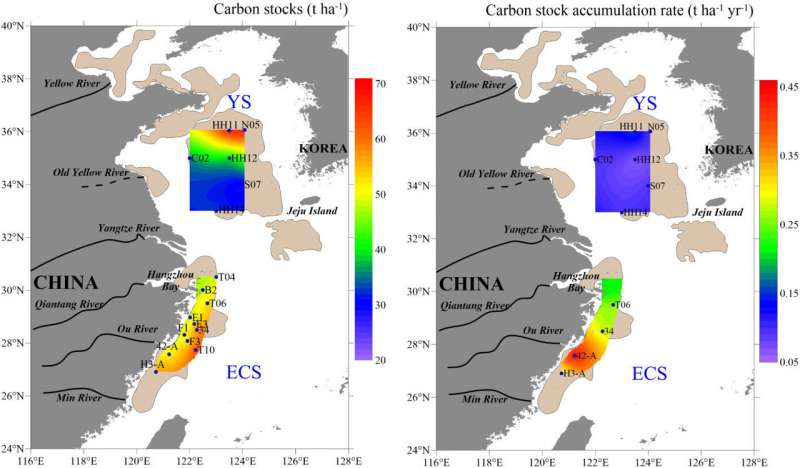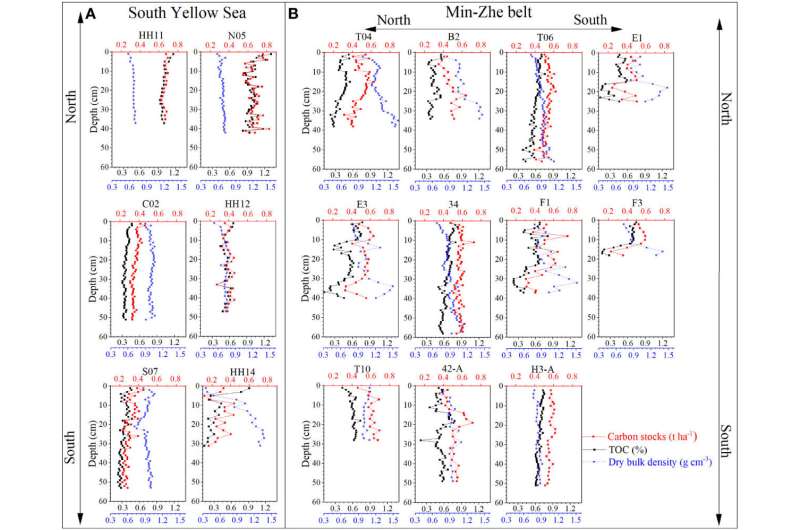
Carbon storage has been a key focus in recent years to draw down natural and anthropogenic sources of carbon dioxide and help the fight against global warming, and particularly focuses on terrestrial forests and soils, as well as wetland mangroves and seagrasses.
An alternative carbon reservoir can be found in marine sediments, such as those on marginal continental shelves, which account for only 8% of the world's ocean area but have the capacity to store 80% of the planet's organic carbon (126.2 teragrams per year). Marine organic carbon is derived from phytoplankton and the metabolic actions of microbes in sediments, while terrestrial sources from riverine transport and coastal erosion also bring carbon-rich material to the ocean floor.New research, published in Frontiers in Marine Science, has calculated carbon storage in the western Pacific Ocean since 1855, noting specifically the negative impact of reservoir construction on carbon stocks.
Dr. Haili Ma, of the Ocean University of China, and colleagues took 17 sediment cores from the South Yellow Sea and East China Sea, measuring for total organic carbon (the concentration of organic carbon in a sample, derived from nature through plants, for example).
A number of key trends were identified in the data: 1) declining carbon stocks between 1855 and 1950, attributed to extreme flooding in 1851 to 1855 causing the Yellow River to change its course and relocate the terminating estuary; 2) increased carbon stocks post-1950 due to wind-enhanced transport of sediment by the South Shandong Coastal Current during winter monsoons; and 3) reduced carbon stocks since 1990 due to lower sediment transport along the Yangtze River with reservoirs and dams built upstream.
The research team calculated the global average carbon stocks in marine sediments to be 66.6 tons per hectare (t/ha), while that of the South Yellow Sea was reduced by 32% to 45.2 t/ha. Despite this, sediment accumulation rates are comparatively higher in the region (2.7 mm/yr), producing a carbon stock accumulation rate of 0.31 t/ha/yr.
Combined with the large size of the marginal marine area on the continental shelf here (4.7 million km2), the scientists estimate a staggering 0.75 petagrams of carbon could be stored. Nevertheless, this is a fraction of the atmospheric carbon growth rate, calculated to be 5.4 ± 0.2 petagrams per year, of which only 40% had the capacity to be absorbed by the oceans.

Within the 17 sediment cores, total organic carbon content ranged 0.12–1.31%, with a general small decrease downcore and a negative correlation with dry bulk density, referencing the compaction of the sediments and the influence of grain size on weight and volume. There is a noticeable trend in declining total organic carbon content from north to south through the study area, matching an increase in sediment grain size.
Meanwhile, the carbon reservoir stocks varied 0.12–0.83 t/ha across the study region, but showed a noticeable decline since the early 1990s, following construction of reservoirs in the Ou River basin in 1988 and 1989, whose course terminates in the sampled seas. Since then, further construction has seen the Three Gorges Dam built in 2003 along the Yangtze River, reducing sediment transport by 63% compared to 1950 and therefore the capacity to transport carbon for burial on the marginal marine shelf.
This research is important as it highlights humanity's interference in other areas of the environment having unforeseen circumstances on the carbon cycle. The siting of dams and reservoirs in years to come must take into consideration the negative impact on carbon stocks, and therefore global warming by allowing organic carbon to re-enter the atmosphere, in addition to more localized effects.
More information: Haili Ma et al, Carbon stocks in the mud areas of the Chinese marginal seas, Frontiers in Marine Science (2023). DOI: 10.3389/fmars.2023.1282891
Journal information: Frontiers in Marine Science
(Source: https://phys.org/news/2023-11-reservoir-carbon-storage-ocean-sediments.html)